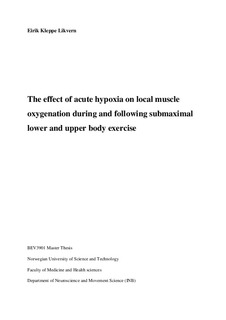The effect of acute hypoxia on local muscle oxygenation during and following submaximal lower and upper body exercise
Master thesis
Permanent lenke
http://hdl.handle.net/11250/2565342Utgivelsesdato
2018Metadata
Vis full innførselSamlinger
Sammendrag
Background: The effect of hypoxia on VO2max and peak power is attenuated when less muscle mass is involved. Near infrared spectroscopy (NIRS) has been extensively used to investigate local differences in muscle oxygenation during exercise. Muscle oxygenation is reduced in the lower body during exercise in hypoxia, but the effect of hypoxia on muscle oxygenation during upper body exercise is not well known. Aim: To investigate the effects of acute hypoxia on local muscle oxygenation during and after submaximal upper and lower body exercise. Methods: Nine actively competing male rowers and one cross-country skier (n=10) completed a total of four submaximal exercise protocols at 70% of MAP using a leg-cycle ergometer and an arm-crank ergometer during normoxia and hypoxia: normoxic leg-cycling, hypoxic leg-cycling, normoxic arm-cranking and hypoxic arm-cranking. Local muscle SmO2 and mVO2-recovery in the vastus lateralis and biceps brachii were measured, as well as whole body cardiopulmonary variables, lactate, and RPE. Results: Hypoxia does not affect SmO2, tHb, VO2 or heart rate differently during upper and lower body exercise, but the lactate and ventilation response was more pronounced during leg-cycling than arm-cranking. The post-exercise mVO2 recovery time constant increased in hypoxia during arm-cranking, but not leg-cycling. Conclusion: Exercise intensity was in the anaerobic domain, and too high for significant differences in aerobic metabolism to occur. The effect of hypoxia and exercise mode on the recovery time constant is uncertain due to issues using standardized data analysis. Further research is needed to investigate the effect of hypoxia on local muscle oxygenation during and after aerobic submaximal upper and lower body exercise.
